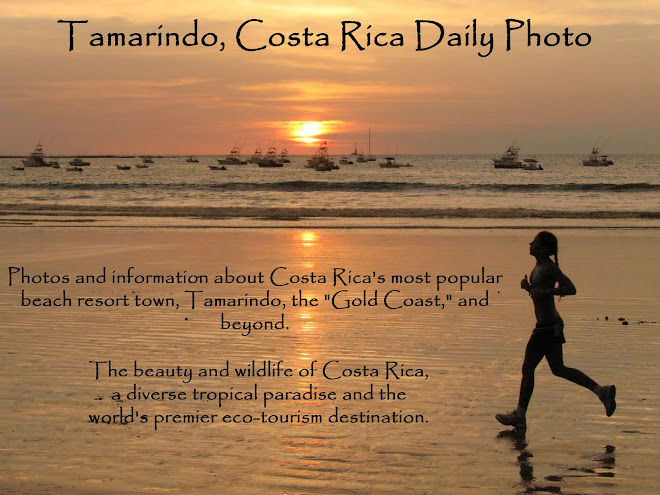 Yesterday I wrote about a first for Costa Rica -- its designation as a World BioGem. Today, I will talk about something else that makes Costa Rica unique. It is the only country in the world that has adopted a free trade treaty through a vote of the people. I will also explain the relevancy of this photo of banana workers, as the European Union is currently thwarting the import of cheaper bananas from Costa Rica.
Yesterday I wrote about a first for Costa Rica -- its designation as a World BioGem. Today, I will talk about something else that makes Costa Rica unique. It is the only country in the world that has adopted a free trade treaty through a vote of the people. I will also explain the relevancy of this photo of banana workers, as the European Union is currently thwarting the import of cheaper bananas from Costa Rica.The USA and Central American countries have adopted the Central American Free Trade Agreement, or CAFTA. Because Costa Rica has such a strong democratic tradition (unlike many Latin American countries), people were successful in forcing a national referendum election in Costa Rica on whether to ratify CAFTA a year or so ago. Many Costa Ricans, particularly farmers, opposed the treaty because they feared that a flood of cheaper imports would undermine local businesses and jobs.
Think about your own country. If there were a public vote on whether to make it easier for foreign products to compete with the products made by workers in your own country, do you think the people would vote for it?
The Nobel Peace Prize winning President of Costa Rica, Oscar Arias, explained to the people that CAFTA would benefit the regional economy by opening up other markets to products made in Costa Rica. This was a "tough sell" to Costa Rica, which is still heavily agricultural and most farmers are small family farmers and they feared having to compete with the giant U.S. agri-businesses.
The voters approved CAFTA by a narrow margin, which made Costa Rica the only country on earth that has approved a free trade agreement by a vote of the people. This is strong evidence not only of the democratic tradition in the country, but of the educational system that the voting public could and did think through the long-range implications of the complex issue of foreign trade.
So, what has happened in the year or so since CAFTA was ratified? Well, during the past week two significant developments have happened. After a 3 year process of negotiations, inspections, and U.S. government review, Costa Rica has been approved to be able to export tomatoes and peppers to the U.S. This will help the Costa Rican economy, and greenhouses will be built and expanded to produce these crops year-round for export.
The news from Europe is not as good. There are negotiations going on right now between Central American and European trade authorities, and they are going very slowly and progress is not satisfactory. The European Union has proposed only modest reductions in the tariffs on banana imports. I am sure that there are not local banana farmers in Europe that they are trying to protect, so why make bananas more expensive for Europeans?
I have used a photo today of banana workers to illustrate this discussion of free trade. For the Europeans who read this blog, wouldn't you like some Costa Rican bananas at a cheaper price?
I apologize for discussing a "heavy" economic subject, and I promise that tomorrow I will return to the usual photos of beaches, wildlife and plants that you typically see on this website. But after sharing the news yesterday of the BioGem designation of Costa Rica, I thought I would share the news on the issue of foreign trade, as anything that stimulates the economy is so important to Costa Rica and the world in these challenging times.

You make living in Costa Rica sound more appealing every day.
ReplyDeleteHmm! I wonder if it's going to work out as planned in the long run. I certainly hope so. What is the issue of pesticides and bananas in CR these days?
ReplyDeleteInteresting commentary on an important subject.
ReplyDeleteVery interesting post! Actually I buy many fruits coming from Costa Rica.
ReplyDeletePortugal has a lot of banana farms at Madeira Island, but I'm sure this is not the reason for Europe to make this fruit trade more difficult... Do you know Iceland also produces banana? In greenhouses, of course! lol!
Mmmmm, I had a banana for breakfast this morning.
ReplyDeleteKate,
ReplyDeleteYou have raised an interesting issue about the banana industry in Costa Rica. I will post some information about its fascinating history and influence on the development of Costa Rica in the very near future.
JM,
ReplyDeleteYou amaze me with your information about bananas being raised in Iceland. If you had asked me what do Iceland and Costa Rica have in common, I would have answered volcanoes, not bananas.
For people of my generation (age 58 and above), we may remember Carmen Miranda in TV comercials singing about Chiquita Bananas while wearing a straw hat filled with fruit. If Iceland wants to get in on the tropical ambiance, maybe they should use someone like her to sing in commercials with a straw hat filled with cod fish.
I never really thought about it before -- that there must be a banana plant somewhere to process all those bananas I eat. I have one every morning.
ReplyDelete